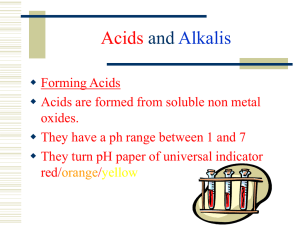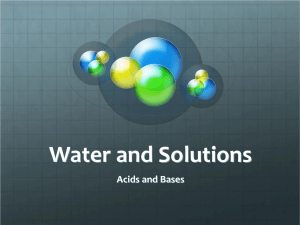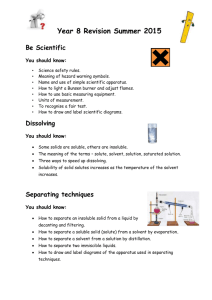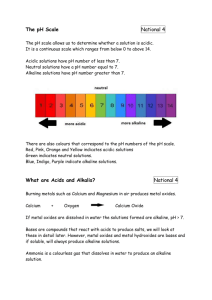Smithycroft Secondary S3 Chemistry Unit 1: Section 5 – Acids and
advertisement
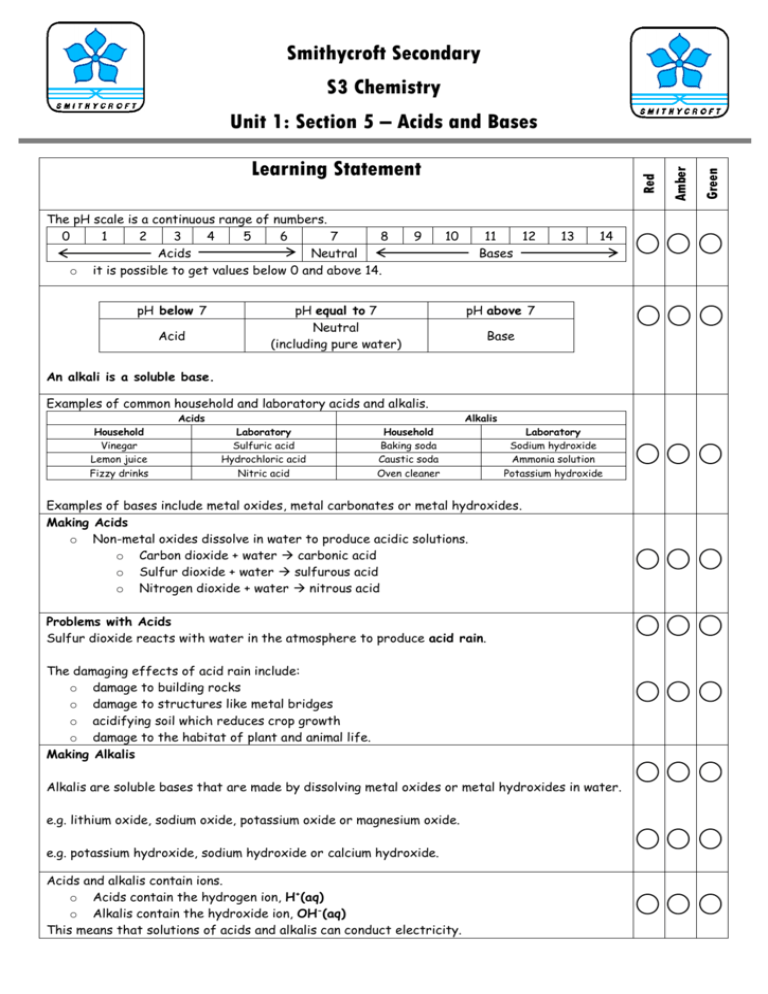
Smithycroft Secondary S3 Chemistry The pH scale is a continuous range of numbers. 0 1 2 3 4 5 6 7 8 Acids Neutral o it is possible to get values below 0 and above 14. pH below 7 Acid 9 10 pH equal to 7 Neutral (including pure water) 11 12 Bases 13 14 pH above 7 Base An alkali is a soluble base. Examples of common household and laboratory acids and alkalis. Acids Household Vinegar Lemon juice Fizzy drinks Alkalis Laboratory Sulfuric acid Hydrochloric acid Nitric acid Household Baking soda Caustic soda Oven cleaner Laboratory Sodium hydroxide Ammonia solution Potassium hydroxide Examples of bases include metal oxides, metal carbonates or metal hydroxides. Making Acids o Non-metal oxides dissolve in water to produce acidic solutions. o Carbon dioxide + water carbonic acid o Sulfur dioxide + water sulfurous acid o Nitrogen dioxide + water nitrous acid Problems with Acids Sulfur dioxide reacts with water in the atmosphere to produce acid rain. The damaging effects of acid rain include: o damage to building rocks o damage to structures like metal bridges o acidifying soil which reduces crop growth o damage to the habitat of plant and animal life. Making Alkalis Alkalis are soluble bases that are made by dissolving metal oxides or metal hydroxides in water. e.g. lithium oxide, sodium oxide, potassium oxide or magnesium oxide. e.g. potassium hydroxide, sodium hydroxide or calcium hydroxide. Acids and alkalis contain ions. o Acids contain the hydrogen ion, H+(aq) o Alkalis contain the hydroxide ion, OH-(aq) This means that solutions of acids and alkalis can conduct electricity. Green Red Learning Statement Amber Unit 1: Section 5 – Acids and Bases Acidic and alkaline solutions contain the following ions: Type Acid Neutral Alkali Ion(s) Present H+(aq) and OH-(aq) H+(aq) and OH-(aq) H+(aq) and OH-(aq) Numbers of Ions H+(aq) > OH-(aq) H+(aq) = OH-(aq) H+(aq) <OH-(aq) Diluting solutions of acids or alkalis has the following effects. Type of Solution Acid Neutral Effect of Dilution on pH 07 77 Effect of Dilution on Solution Acidity decreases No change Alkali 14 7 Alkalinity decreases. Effect of Dilution on Ions Decrease in the concentration of H+(aq) ions No change in the concentration of H+(aq) or OH-(aq) ions. H+(aq) = OH-(aq) Decrease in the concentration of OH-(aq) ions When an acid reacts with a base a reaction called neutralisation occurs. Neutralisation changes the pH of acids and bases. Type of Substance Acid Base Effect on pH Increases to 7 Decreases to 7 Example of pH Change pH = 0 pH = 7 pH = 14 pH =7 There are many everyday examples of neutralisation reactions. o Reducing soil acidity by adding lime. o The use of lime to reduce acidity in lakes caused by acid rain. o Treatment of indigestion. o Treating wasp or bee stings. In neutralisation the hydrogen ions in acids react with the hydroxide ions found in alkalis to form water. H+(aq) + OH-(aq) H2O(l) hydrogen ion + hydroxide ion water In reactions involving metal carbonates, carbon dioxide gas is also formed. 2H+(aq) + CO32-(aq) CO2(g) + H2O(l) hydrogen ions + carbonate ion carbon dioxide + water Acids react with bases and metals to form salts. The chemical test for hydrogen gas is that it ignites with a squeaky pop. The chemical test for carbon dioxide is that it turns lime water chalky. A salt is a substance in which the hydrogen ion of an acid has been replaced by a metal ion. o Ammonium ions (NH4+) can also replace hydrogen ions (H+) to make salts. o Most ionic substances are salts (except oxides and hydroxides). To name the salt formed in reactions, we have to use the name of the acid and base. o o The neutraliser provides the first name of the salt formed. Neutraliser Name Sodium hydroxide Potassium oxide Calcium Carbonate First Name of Salt Sodium Potassium Calcium The acid provides the second name of the salt formed. Acid Name Hydrochloric acid Sulfuric acid Nitric acid Second Name of Salt …chloride …sulfate …nitrate There are 2 types of salt: soluble and insoluble. Making Soluble Salts Soluble salts are made by (1) Neutralisation, (2) Filtration and (3) Evaporation. Making Insoluble Salts Insoluble salts are made by a precipitation reaction. This involves mixing two solutions and forming a powdery solid called a precipitate. **The precipitate is the insoluble salt** A special technique can be carried out to accurately work out how much base is needed to neutralise an acid. This technique is called a titration. Titration experiments involve using the following apparatus: 1. A Pipette A pipette is used to accurately measure out a volume of solution into a conical flask. 2. A Burette A burette is a graduated piece of glassware with a tap at the bottom of it. It can be used to release small volumes of a solution into a conical flask. Using small volumes of solution, sometimes drop by drop, allows a high degree of precision in this technique. An indicator is also added to the titration flask, which will change colour when the neutralisation has taken place. In this technique you should always swirl the titration flask as you are running solution from the burette into it, this ensures thorough mixing of the chemicals. A white tile should also be placed under the titration flask to allow the colour change to be clearly seen. In a titration experiment results must be concordant. This means that volume readings from the burette should be within 0.2 cm3 of each other. Results should be recorded in a table like the following. Rough Run 1 3 0 16.2 Start Volume (cm ) Run 2 32.3 End Volume (cm3) 16.2 32.3 48.5 Titre (cm3) 16.2 16.1 16.2 𝐴𝑣𝑒𝑟𝑎𝑔𝑒 𝑇𝑖𝑡𝑟𝑒 = 𝑅𝑢𝑛 1 + 𝑅𝑢𝑛 2 2 **Never use the rough titre value in any calculation**

